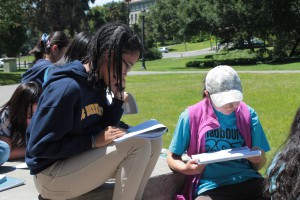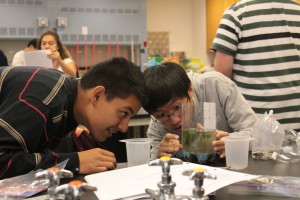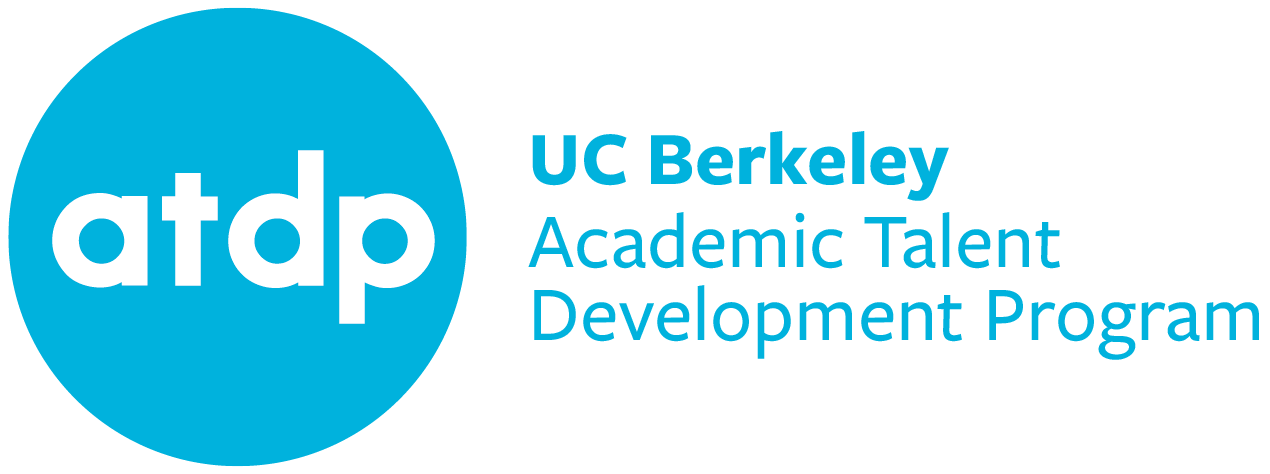It’s only the second week of classes, and already, Secondary Division students ranging from sixth grade writers to eleventh grade neuroscientists are taking full advantage of the natural and academic resources that UC Berkeley’s campus has to offer.
The Writing Process

In her Writing Process classes, Lisa Griffin makes sure to highlight the beauty and history embedded in the campus by taking her students to campus landmarks like Sproul Plaza and by creating writing exercises that give students an opportunity to reflect on this unique setting. This Tuesday, The Writing Process ventured to the Valley Life Sciences Building, which is surrounded by an impressive variety of trees.
After some focused reading in the sunshine, students gathered around Ms. Griffin and accepted their mission: to write a detailed, evocative description of one tree using figurative language and drawing upon the richness of nature. According to Ms. Griffin, this activity was inspired by UC Berkeley professor and former poet laureate Robert Hass, who “took his writing classes outside to write about the natural environment they saw around them.” Haas noticed that his students could not name the trees that they saw and even had trouble describing them with any depth. Ms. Griffin remembers that Hass “said something like, ‘How can we care about something enough to save it, if we don’t know its name?’”
As students broke into pairs to “meet a tree,” Ms. Griffin mused, “I like to imagine them, years later, coming across this same tree with a connection to it.”
Environmental Science

Meanwhile, inside the Valley Life Sciences Building, students of Environmental Science used water and soil from a campus creek, along with living plants and animals (fish, shrimp, worms, etc.) provided by instructors or brought from home, to design and build self-contained sustainable ecosystems! Jonathan Wright, co-instructor for Environmental Science, explains the project:
“The purpose of the Ecocolumn is to illustrate the complexity of the biosphere by having students try to construct their own. Can students build a sustainable ecosystem that is completely sealed from the outside? That means there is no way for air/food/water to get in or out. Can it continue to sustain life for the duration of ATDP? It turns out it is really hard to do! Students learn about biogeochemical cycles, energy flow and conversion, and food webs, all while illustrating the complexity and fragility of our global environment. On top of that, it provides a context for students to understand the science behind environmental problems, such as the giant “dead zone” in the Gulf of Mexico.”
Our young scientists will see signs of life in their bottled worlds astoundingly soon. “Come back in about a week,” co-instructor Thomas Ryan advised, “and you should already be able to be able to see the strength of the ecosystem.”
Cognitive Neuroscience

A Cognitive Neuroscience field trip on Wednesday took advantage of one of the campus’s very newest offerings. The Henry H. Wheeler Jr. Brain Imaging Center (BIC) is now housed in the brand-spanking-new Li Ka Shing Center for Biomedical and Health Sciences. Guided by Ben Inglis, the BIC’s manager and physicist, ATDP students toured the (enormous) new Center, got hands-on time with the Center’s brain scanner, and watched the scanner in action while they monitored activity in their instructor’s brain!
Professor Bulakowski sees this annual field trip as an opportunity not only for his students but for the field of cognitive neuroscience:
This younger generation of students is growing into a world where the application of brain based technologies is common. Along with new technology comes the promise of understanding the brain in health and disease, but also a responsibility to use it ethically. Early exposure to the world of cognitive neuroscience will help enable these students to make informed decisions and make the most exciting discoveries in the future.
Just as Jonathan Wright’s and Thomas Ryan’s science students practice sustaining an environment and Lisa Griffin’s writing students practice sustaining detailed, engaged writing, Paul Bulakowski’s neuroscience students gain experience with the technologies that will help them to sustain the progress we’ve made in understanding the human brain. Like an Ecocolumn, UC Berkeley’s and ATDP’s successes depend not only on what students and faculty put in but also on how effectively we use what is already here. Secondary Division students, I congratulate you for making the most of what this campus has to offer! Keep up the good work.
